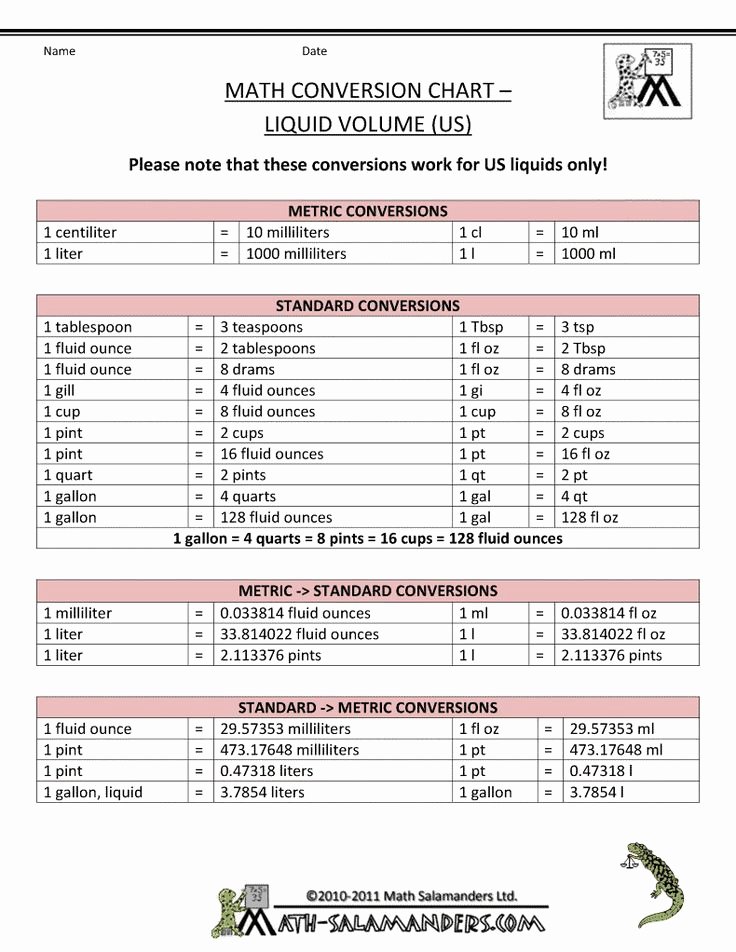

This is because these measurements are universal and give the most accurate and consistent results when it comes to baking.įor example, the weight of 1 US cup of granulated white sugar can vary from brand to brand, depending on the size of the granules. You will find that the recipes on this blog predominantly use grams and ounces for measurements. Pan Grilled Steaks with Bearnaise Butter.Lemon Curd and a darned good Lemon Drizzle Cake.Cauliflower Gratin with a Horseradish Crust.= Three and three-quarter cups.ġ and 3-quarter pints, 1 litre, = 4 and a half cups.
#Conversion charts for liquid measurements plus#
Using the one-cup standard measure as sold here in the UK (NB: Please remember to alter the amount for your own recipe):-ġlb (450g) butter or margarine = 2 cups (or four sticks).ġlb 450 g, granulated or caster, (superfine), sugar = 2 cups.ġlb 450 g, icing sugar (confectioners' sugar) = 3 cups.Ĥ oz, 110 g, icing sugar, (confectioner's sugar), = half a cup plus a heaped tbsp.Ĩ oz, 225 g, butter, margarine, or shortening = one cup (or two sticks).Ĥ oz, 110 g, butter, margarine, or shortening = half a cup (or one stick).Ģ oz, 50 g, butter, margarine or shortening = a quarter of a cup (or half a stick).Ĥ oz, 110 g, dried mixed fruit, (fruitcake mix) = 2-thirds of a cup.Ģ oz, 50 g, dried mixed fruit, (fruit cake mix) = one-third of a cup.ģ oz, 75 g, plain, (semi-sweet) chocolate, broken into squares = 3-quarters of a cup.Ģ oz, 50 g, flaked, (slivered) almonds = half a cup.ġ oz, 25 g, is one heaped or heaping, tbsp of flour, oatmeal, cheese, breadcrumbs, or icing, confectioners grade, sugar.ġ oz, 25 g, is 1 rounded tbsp, of granulated or caster, superfine, sugar.ġ oz, 25 g, is 2 level tbsp of butter, margarine or shortening. Purchasing a good set of balance scales with either metric or imperial weights, really will eliminate any guesswork and give good, consistent results every time. If in doubt, weighing is still the most reliable and much preferred method to use, even by many American cooks. The only advice I would offer, having spent hours trawling websites and reading through books for factual information, hints and tips, is, to be consistent, never mix imperial, metric or cup measures in one recipe, If you use the same measuring system throughout, your dishes should work out correctly. The listings below should enable recipes to be successfully made by American cooks. flour, breadcrumbs and oatmeal will be 4 oz, (110 g), but sugar, butter, dried fruit, chopped vegetables, syrup etc., will weigh differently. Bear in mind that the same cup measures differently for liquid and dry, depending on the weight of the ingredient, i.e. The standard American measuring cups sold here in the UK are one 4 ounce cup and smaller, Many American recipes use an 8 ounce (two cup) as a basis for measuring recipe ingredients. Similarly a British pint measures 20 fluid ounces while an American pint is just 16 fluid ounces.


For example a British standard tablespoon holds 17.7ml while the American tablespoon has a 14.2 ml capacity. There are sometimes significant differences between the measures used for ingredients in British and American recipes. I've had some requests to sort out the measuring problems that some of you are having in understanding the difference between British and American measures and converting them, so I am posting a handy list here for future reference! Hope this helps!Ĭonverting British weights and measures to American


 0 kommentar(er)
0 kommentar(er)
